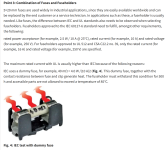Hi all,
I am building a class D power amplifier and got a bit confused on how to read the specification on the power switch and whether it will actually work for the purpose.
This is a 200W mono construction, 400VA/40V toroid transformer with 200 uF filter caps and a 2 second softstart from the late Newclassd solution
The power switch I have bought is specified to 10A 250V, but got a bit confused on the fuse power specification on 2W for one-pole and 1.6W for 2-pole. Have I bought the wrong switch for this application? Any suggestions to what spec I need - both for the switch and what fuse to use 🙂
The switch: https://docs.rs-online.com/dd66/0900766b81148d4e.pdf
and the specification sheet:

I am building a class D power amplifier and got a bit confused on how to read the specification on the power switch and whether it will actually work for the purpose.
This is a 200W mono construction, 400VA/40V toroid transformer with 200 uF filter caps and a 2 second softstart from the late Newclassd solution
The power switch I have bought is specified to 10A 250V, but got a bit confused on the fuse power specification on 2W for one-pole and 1.6W for 2-pole. Have I bought the wrong switch for this application? Any suggestions to what spec I need - both for the switch and what fuse to use 🙂
The switch: https://docs.rs-online.com/dd66/0900766b81148d4e.pdf
and the specification sheet:
They do specify fuse holders in watts. Have a look at this web page , excerpted below.
The Schurter DD11 datasheet follows the IEC standard, which uses an 0.040 ohm dummy fuse (plus fuse holder contact resistance). Assuming the contact resistance is 2% of the dummy fuse value, at each end of the fuse, then Imax * Imax * (0.040 * 1.04) = 2.0 watts. Thus Imax = 6.93 amperes.
_
The Schurter DD11 datasheet follows the IEC standard, which uses an 0.040 ohm dummy fuse (plus fuse holder contact resistance). Assuming the contact resistance is 2% of the dummy fuse value, at each end of the fuse, then Imax * Imax * (0.040 * 1.04) = 2.0 watts. Thus Imax = 6.93 amperes.
_
Attachments
Yes the wattage for the fuses is so the switch housing doesn't melt and catch fire before the fuses blow. So essential to get right. You'll need to check the fuse curves for maximum voltage drop at maximum current for the particular fuses you choose. You just need to check the datasheet. It may be that this isn't a difficult restruction to meet, or perhaps it is - I don't have a feel for it, you have to do the maths. If you are lucky the datasheet will have the watts precalculated for you.
You often see stickers by fuses saying "only replace with exact same type", now you know one reason why...
You often see stickers by fuses saying "only replace with exact same type", now you know one reason why...
